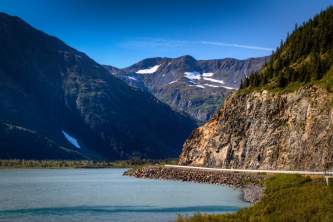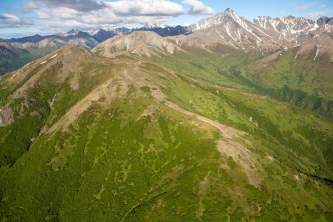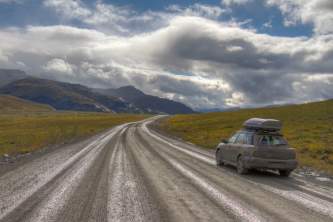Alaska Bore Tide
The bore tide is a spectacular sight, a wave up to 10 feet high, that thunders into Turnagain Arm just south of Anchorage in the right tide conditions. You can easily see this dramatic show of nature’s power from the Seward Highway using our guidelines below.
What Are Bore Tides?
The bore tide is a rush of seawater that returns to a shallow and narrowing inlet from a broad bay. Bore tides come in after extreme minus low tides created by the full or new moon.
Bore tides occur all over the world—there are around 60 of them—but only a few are large enough to make a name for themselves. One in China, for example, stretches almost 30 feet tall and travels more than 20 miles per hour. Alaska’s most famous bore tide occurs in Turnagain Arm, just outside Anchorage. It builds up to 6 – 10 feet tall and can reach speeds of 10 to 15 miles per hour. It takes not just a low tide but also about a 27-foot tidal differential (between high and low tide) for a bore to form in Turnagain Arm.
The Thrill of Witnessing A Bore Tide along Turnagain Arm
Read and see imagery from photographer Jeff Schultz's first-hand account of seeing the bore tide
What's So Special About the Turnagain Arm Bore Tide?
Well, it’s huge—one of the biggest in the world, actually. Also, all other bore waves run up low-lying rivers in more southerly latitudes. The Turnagain Arm bore wave is the only one that occurs in the far north and the only one bordered by mountains, making it the most unique and most geologically dramatic bore tide in the world. It’s also amazingly accessible: you can see it from the Seward Highway along its entire 40- to 50-mile length. And it’s a wildlife-spotting opportunity: harbor seals often ride the tide into Turnagain Arm. Beluga whales may come in a half hour or so later once the water gets deeper.
Where to See The Bore Tide
See tide tables below for Beluga Point and Bird Ridge
It's amazingly accessible: you can see it by road along its entire 40- to 50-mile length along Turnagain Arm near Anchorage. Plus, it's a wildlife-spotting opportunity: harbor seals often ride the tide into Turnagain Arm, and beluga whales may come in a half hour or so later once the water gets deeper to feed off fish that come in on the tide. The best spots:
- Beluga Point, a 20-minute drive south from Anchorage. The best viewing is from there all the way down to Portage, about an hour south of town. There are five highway pullouts along this stretch. The highway traverses the shoreline along the flats, giving you a real sense for the power and scale of the bore tide.
- Bird Ridge, about 30 minutes south of town, where you can get a wider but more distant view.
- Hope, a town across Turnagain Arm, but it's a good 100-mile drive from Anchorage and takes a little under 2 hours to get there.
When Can I See The Bore Tide?
Tidal bores occur on Turnagain Arm every day, but most produce relatively modest waves. In theory, you would expect the largest bore tides to occur on tides with the highest tidal differential. In reality, they tend to occur just before or after that. This means your chances for seeing a large bore are best during the five-day window that surrounds the new and full moons. Get the dates for new and full moons from the NOAA site. During this window, get the times for the two Anchorage low tides occurring each day either from tide charts available at gas stations or in the table below.
Extreme low tides promise the largest bores because of the amount of water rushing back into the inlet. Also, tides tend to be greatest annually at the equinoxes (March and September), particularly during the fall equinox, so look for especially strong bore tides if you’re traveling then.
Additional How-to Tips
Don't stop with just one.You can watch the bore go by at the first pullout, then drive your car down a pullout or two and watch it come by again. It takes over five hours for the bore to travel from the mouth of Turnagain Arm to the end of it.
Never walk out onto the mud flats. People have died by getting stuck in the glacial silt and being drowned by the incoming tide!
Best Bore Tides of 2025
Bird Point Bore Tides
The bore tide should reach Bird Point 2 hrs and 30 minutes after Anchorage/Fire Island low tide. If the wind is blowing down the arm (the way it always blows—just look at how the trees grow), add another 10-15 minutes.
| Date | Tide Height | Estimated Time of Bore at Bird Point |
|---|---|---|
| May 25, 2025 | -2.0 | 3:32 PM |
| May 26, 2025 | -3.0 | 4:26 PM |
| May 27, 2025 | -3.6 | 5:16 PM |
| May 28, 2025 | -3.6 | 6:03 PM |
| May 29, 2025 | -3.1 | 6:48 PM |
| May 30, 2025 | -2.1 | 7:31 PM |
| June 24, 2025 | -2.3 | 4:14 PM |
| June 25, 2025 | -3.0 | 5:05 PM |
| June 26, 2025 | -3.2 | 5:50 PM |
| June 27, 2025 | -2.8 | 6:32 PM |
| June 28, 2025 | -2.0 | 7:11 PM |
| July 24, 2025 | -2.4 | 4:51 PM |
| July 25, 2025 | -2.6 | 5:33 PM |
| July 26, 2025 | -2.1 | 6:10 PM |
| August 10, 2025 | -2.0 | 5:50 PM |
Beluga Point Bore Tides
| Date | Tide Height | Estimated Time of Bore at Bird Point |
|---|---|---|
| May 25, 2025 | -2.0 | 2:32 PM |
| May 26, 2025 | -3.0 | 3:26 PM |
| May 27, 2025 | -3.6 | 4:16 PM |
| May 28, 2025 | -3.6 | 5:03 PM |
| May 29, 2025 | -3.1 | 5:48 PM |
| May 30, 2025 | -2.1 | 6:31 PM |
| June 24, 2025 | -2.3 | 3:14 PM |
| June 25, 2025 | -3.0 | 4:05 PM |
| June 26, 2025 | -3.2 | 4:50 PM |
| June 27, 2025 | -2.8 | 5:32 PM |
| June 28, 2025 | -2.0 | 6:11 PM |
| July 24, 2025 | -2.4 | 3:51 PM |
| July 25, 2025 | -2.6 | 4:33 PM |
| July 26, 2025 | -2.1 | 5:10 PM |
| August 10, 2025 | -2.0 | 4:50 PM |
Get Bob's Newsletter
Personal stories, experiences, and advice you won't find anywhere else.



